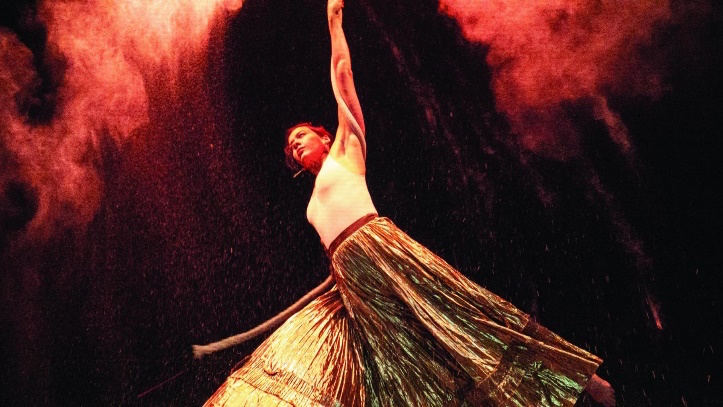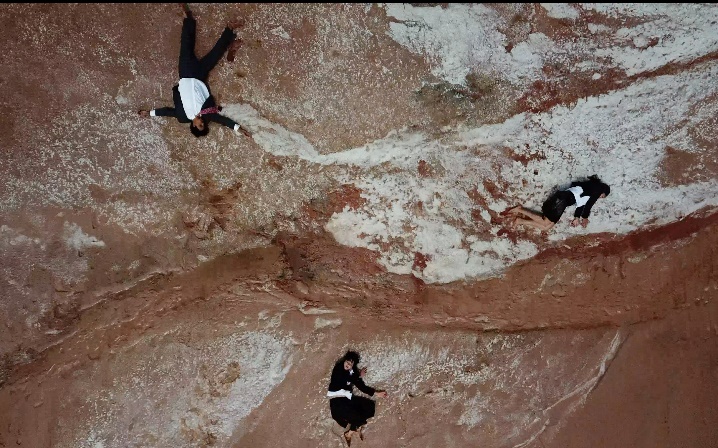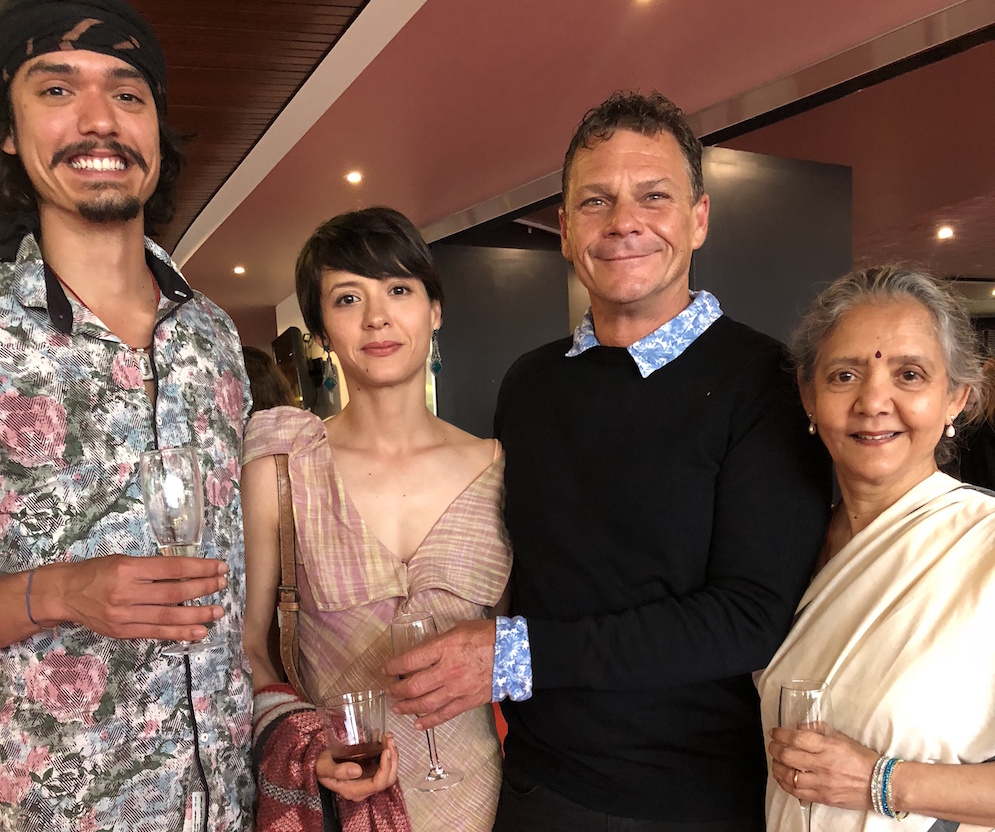Daksha Sheth presents ‘Kwongkan – Sand’ at Perth International Art festival
By Sudha Kumar

Perth International Art Festival has Ochre Contemporary Dance Company, Perth, and Daksha Sheth Dance Company, India, together bring to us ”˜Kwongkan’. Ochre Contemporary Dance Company is regarded as one of Australia’s leading physical theatre companies. Daksha Sheth Dance Company is one of India’s leading dance companies, having toured internationally for 25 years.
”˜Kwongkan’ journeys from ancient cultures, through the present and into a future where the next generation struggles to save the planet and themselves. An apocalyptic foreboding of the effects of climate change, Kwongkan is visually and sonically startling with passionately powerful physical performance at its core.

”˜Kwongkan’ means ”˜sand’ in Indigenous South Western Australian Nyoongar language. It is an indestructible element used in dance ceremonies in both Indian and Indigenous Australian cultures. The title is also a reference to what most of us are doing about addressing the tsunami of climate catastrophes engulfing our planet ”“ putting our heads in the sand. People connected to sacred lands are at the forefront of the impact of climate change.”
After presenting ”˜Shiva Shakthi’ in 2013 which was based on the innermost power of the ”˜self’ brother- sister duo Tao Issaro and Isha Sharvani are back in Australia, along with Noongyar dancer Ian Wilkes to present ”˜Kwongkan ”“ Sand’. Tao and Isha are the children of India’s famous dancer Daksha Sheth and Australian musician Dev Issaro. Daksha Sheth Dance Company is a co commissioner of ”˜Kwongkan’ for the Perth International Art Festival.
I spoke with both Isha and Tao on their perspectives, experiences and more. It was a pleasure to converse with them.

- What would you like to say about ’KWONGKAN ”“ SAND’?
Tao: Kwongkan is more than just a dance show. It is a call to acknowledge climate change, presenting a ”˜word scape’ scenario of climate change. We sit at a dangerous tipping point and the consequences are hitting home like never before. Natural disasters around the world have become a norm. Floods, bushfires, hurricanes and tsunamis dot the globe. And this is a direct consequence of human action. Kwongkan therefore is this story told from the eyes of ancient cultures of India and Australia, almost like a premonition of what is to come.
Isha: Kwongkan is three years in the making. It is an attempt to ”˜make changes happen’, beyond the discussions, demonstrations and awareness campaigns. We engaged with social activists and scientists in bringing this together. We have a duty towards giving our children and their children an opportunity at ”˜life’. Ancient cultures preserved nature for thousands of years. We have brought about unprecedented and almost irreparable changes in just two hundred.
2. In preparing for ”˜KWONGKAN-SAND’ you have travelled the sacred lands of both tropical India and desert Australia. What was that experience like?
Isha: Desert life opened up a new perspective for me. Indigenous elders look up to the desert like a higher spiritual being. We also travelled India with three aboriginal indigenous elders who when exploring many ancient Indian practices realised so many unifying aspects.
Tao: Walking the Australian desert is the most humbling experience. You cannot but realise your place in the grand scheme of nature. There is no space for one’s ego. I’ve realised that water is life. Similarly, for the Noongyar dancers, chaotic yet beautiful India was most fascinating. They found a number of transcendental elements common to both cultures. We recognised a closeness to nature that both cultures have.
3. ”˜Kwongkan’ is a classic instance of bringing together of two peoples and cultures for a common bigger cause. What do you think is the impact of performing arts on the amalgamation of people and cultures?
Tao: Performing arts is not an exact science. The impact on the viewer depends on what he/she comes to the space with, and what they walk away with. Our job as performers is to give them an experience beyond the ordinary which they can then carry with them. Sometimes what they experience may never have been intended by the artiste, and yet because they see the expression from the reference point of their life experience, we leave them with an idea. It is in the eyes of the beholder. Artistic expressions, regardless of the medium of art, has the power to touch human hearts and minds.
4. What is greatest the challenge in keeping age old art forms alive.
Tao: For an art form to remain alive it needs to be first learnt and practised in its traditional form. We, my sister and I, are able to contemporise because we have a solid background of the art form in its traditional form and we practise it in its purity before veering off and experimenting without compromising. Times are changing and peoples’ attention span is changing. Some of the traditional art forms catered to a different time and a different audience, and so it is important that it is placed in the ”˜now’. Ancient cultures and art forms need to be preserved, but they also need to be contemporised so that younger generations can see the journey of the art form and have a want to be a part of it. It is a two-way platform.
Isha: We artistes tread two worlds. One being the physical and the other spiritual. Today most people learning an art form tend to focus on the physicality of the art rather than take a holistic approach. The focus needs to shift from the physical to the reasons for the expression of art and how to find a middle ground. We need to find a middle ground where we can live with the art being a part of our life, nurture it with reverence while still living in today’s society.
5. What is the impact of conformity on creativity?
Tao: Pursue not the presentation of the art but the truth behind it. When one explores with an open mind without a preconceived outcome creativity happens. When the outcome is the aim, one tends to conform and limit oneself. You lose the joy and excitement of the journey.
Creativity lies in the unknown, where the artiste is completely vulnerable in not
knowing where the journey is taking him/her. That’s where the magic happens.
Creativity is the search for the unknown.
6. Best moment in Australia?
Tao: Freemantle all the way! Happy to call it my home.
Isha: My best moment is when every day after a long hours of practice, I run into the ocean with my son.
As Isha says, “In today’s world the need of the hour is for communities to come together and integrate. More so for the sake of our young. If we go insular we lose, the more connected we are, we get the opportunity to transfer the beauty of humanity thus enriching each other”.
Ochre Contemporary Dance Company, Perth, Australia and Daksha Sheth Dance Company, India, have done just that by coming together. With the intent of bringing culture and art together and with a universal message that is relevant to every living being. The message urges us to act. Now.
Kwongkan will be presented at :
Venue:
Fremantle Arts Centre
Dates: Sat 16 February-Wed 20 February
Time: 7.30pm, Pre show experience from 5pm Duration:
60 mins
Post Show Conversation: Sun 17 Feb
Tickets: $45, $42 (concession) $25 (Full-time student) Transaction fees
may apply, available at www.perthfestival.com.au
Short URL: https://indiandownunder.com.au/?p=12597
